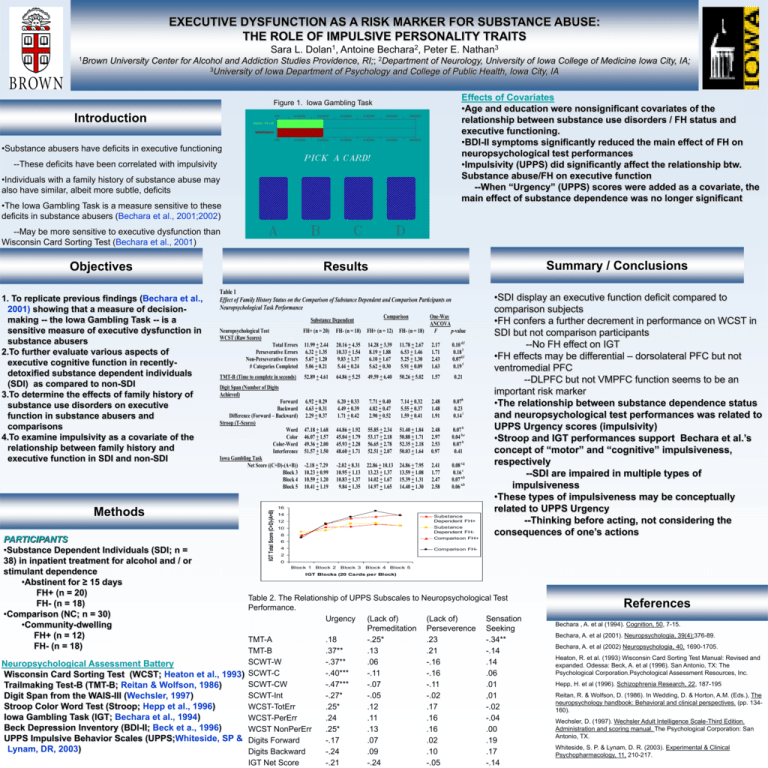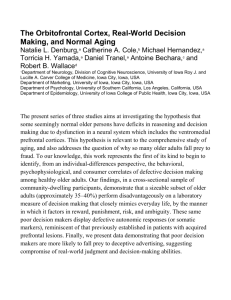28_Dolan GUZE 2007 poster - Midwest Alcoholism Research Center
advertisement

EXECUTIVE DYSFUNCTION AS A RISK MARKER FOR SUBSTANCE ABUSE: THE ROLE OF IMPULSIVE PERSONALITY TRAITS Sara L. Dolan1, Antoine Bechara2, Peter E. Nathan3 1Brown University Center for Alcohol and Addiction Studies Providence, RI;; 2Department of Neurology, University of Iowa College of Medicine Iowa City, IA; 3University of Iowa Department of Psychology and College of Public Health, Iowa City, IA Effects of Covariates •Age and education were nonsignificant covariates of the relationship between substance use disorders / FH status and executive functioning. •BDI-II symptoms significantly reduced the main effect of FH on neuropsychological test performances •Impulsivity (UPPS) did significantly affect the relationship btw. Substance abuse/FH on executive function --When “Urgency” (UPPS) scores were added as a covariate, the main effect of substance dependence was no longer significant Figure 1. Iowa Gambling Task Introduction •Substance abusers have deficits in executive functioning --These deficits have been correlated with impulsivity •Individuals with a family history of substance abuse may also have similar, albeit more subtle, deficits •The Iowa Gambling Task is a measure sensitive to these deficits in substance abusers (Bechara et al., 2001;2002) --May be more sensitive to executive dysfunction than Wisconsin Card Sorting Test (Bechara et al., 2001) Objectives Methods PARTICIPANTS •Substance Dependent Individuals (SDI; n = 38) in inpatient treatment for alcohol and / or stimulant dependence •Abstinent for ≥ 15 days FH+ (n = 20) FH- (n = 18) •Comparison (NC; n = 30) •Community-dwelling FH+ (n = 12) FH- (n = 18) Table 1 Effect of Family History Status on the Comparison of Substance Dependent and Comparison Participants on Neuropsychological Task Performance Comparison One-Way Substance Dependent ANCOVA FH+ (n = 20) FH- (n = 18) FH+ (n = 12) FH- (n = 18) F p-value Neuropsychological Test WCST (Raw Scores) Total Errors Perseverative Errors Non-Perseverative Errors # Categories Completed 11.99 + 2.44 6.32 + 1.35 5.67 + 1.20 5.06 + 0.21 20.16 + 4.35 10.33 + 1.54 9.83 + 1.37 5.44 + 0.24 14.28 + 3.39 8.19 + 1.88 6.10 + 1.67 5.62 + 0.30 11.78 + 2.67 6.53 + 1.46 5.25 + 1.30 5.91 + 0.09 2.17 1.71 2.43 1.63 0.10 d,f 0.18 f 0.07d.f 0.19 f TMT-B (Time to complete in seconds) 52.89 + 4.61 64.86 + 5.25 49.59 + 6.40 50.26 + 5.02 1.57 0.21 h Digit Span (Number of Digits Achieved) Forward Backward Difference (Forward – Backward) Stroop (T-Scores) Word Color Color-Word Interference Iowa Gambling Task Net Score ((C+D)-(A+B)) Block 3 Block 4 Block 5 6.92 + 0.29 4.63 + 0.31 2.29 + 0.37 6.20 + 0.33 4.49 + 0.39 1.71 + 0.42 7.71 + 0.40 4.82 + 0.47 2.90 + 0.52 7.14 + 0.32 5.55 + 0.37 1.59 + 0.41 2.48 1.48 1.91 0.07 0.23 0.14 i 47.18 + 1.68 46.07 + 1.57 49.36 + 2.00 51.57 + 1.50 44.86 + 1.92 45.04 + 1.79 45.93 + 2.28 48.60 + 1.71 55.85 + 2.34 53.17 + 2.18 56.65 + 2.78 52.51 + 2.07 51.40 + 1.84 50.88 + 1.71 52.35 + 2.18 50.03 + 1.64 2.48 2.97 2.53 0.97 0.07 b 0.04 b,e 0.07 b 0.41 -2.18 + 7.29 10.23 + 0.99 10.59 + 1.20 10.41 + 1.19 -2.02 + 8.31 10.95 + 1.13 10.83 + 1.37 9.84 + 1.35 22.86 + 10.13 13.23 + 1.37 14.02 + 1.67 14.97 + 1.65 24.86 + 7.95 13.59 + 1.08 15.39 + 1.31 14.40 + 1.30 2.41 1.77 2.47 2.58 0.08 c,g 0.16 c 0.07 a,b 0.06 a,b 16 IGT Total Score (C+D)-(A+B) 1. To replicate previous findings (Bechara et al., 2001) showing that a measure of decisionmaking -- the Iowa Gambling Task -- is a sensitive measure of executive dysfunction in substance abusers 2.To further evaluate various aspects of executive cognitive function in recentlydetoxified substance dependent individuals (SDI) as compared to non-SDI 3.To determine the effects of family history of substance use disorders on executive function in substance abusers and comparisons 4.To examine impulsivity as a covariate of the relationship between family history and executive function in SDI and non-SDI Summary / Conclusions Results 14 Substance Dependent FH+ 12 Substance Dependent FH- 10 8 Comparison FH+ 6 4 •SDI display an executive function deficit compared to comparison subjects •FH confers a further decrement in performance on WCST in SDI but not comparison participants --No FH effect on IGT •FH effects may be differential – dorsolateral PFC but not ventromedial PFC --DLPFC but not VMPFC function seems to be an important risk marker •The relationship between substance dependence status and neuropsychological test performances was related to UPPS Urgency scores (impulsivity) •Stroop and IGT performances support Bechara et al.’s concept of “motor” and “cognitive” impulsiveness, respectively --SDI are impaired in multiple types of impulsiveness •These types of impulsiveness may be conceptually related to UPPS Urgency --Thinking before acting, not considering the consequences of one’s actions Comparison FH- 2 0 Block 1 Block 2 Block 3 Block 4 Block 5 IGT Blocks (20 Cards per Block) Table 2. The Relationship of UPPS Subscales to Neuropsychological Test Performance. Urgency (Lack of) (Lack of) Sensation Premeditation Perseverence Seeking TMT-A .18 -.25* .23 -.34** TMT-B .37** .13 .21 -.14 SCWT-W -.37** .06 -.16 .14 Neuropsychological Assessment Battery -.40*** -.11 -.16 .06 Wisconsin Card Sorting Test (WCST; Heaton et al., 1993) SCWT-C SCWT-CW -.47*** -.07 -.11 .01 Trailmaking Test-B (TMT-B; Reitan & Wolfson, 1986) SCWT-Int -.27* -.05 -.02 ,01 Digit Span from the WAIS-III (Wechsler, 1997) Stroop Color Word Test (Stroop; Hepp et al., 1996) WCST-TotErr .25* .12 .17 -.02 Iowa Gambling Task (IGT; Bechara et al., 1994) WCST-PerErr .24 .11 .16 -.04 Beck Depression Inventory (BDI-II; Beck et a., 1996) WCST NonPerErr .25* .13 .16 .00 UPPS Impulsive Behavior Scales (UPPS;Whiteside, SP & Digits Forward -.17 .07 .02 .19 Lynam, DR, 2003) Digits Backward -.24 .09 .10 .17 IGT Net Score -.21 -.24 -.05 -.14 References Bechara , A. et al (1994). Cognition, 50, 7-15. Bechara, A. et al (2001). Neuropsychologia, 39(4):376-89. Bechara, A. et al (2002) Neuropsychologia, 40, 1690-1705. Heaton, R. et al. (1993) Wisconsin Card Sorting Test Manual: Revised and expanded. Odessa: Beck, A. et al (1996). San Antonio, TX: The Psychological Corporation.Psychological Assessment Resources, Inc. Hepp, H. et al (1996). Schizophrenia Research, 22, 187-195 Reitan, R. & Wolfson, D. (1986). In Wedding, D. & Horton, A.M. (Eds.), The neuropsychology handbook: Behavioral and clinical perspectives. (pp. 134160). Wechsler, D. (1997). Wechsler Adult Intelligence Scale-Third Edition. Administration and scoring manual. The Psychological Corporation: San Antonio, TX. Whiteside, S. P. & Lynam, D. R. (2003). Experimental & Clinical Psychopharmacology, 11, 210-217.






